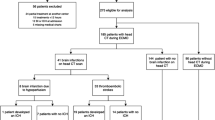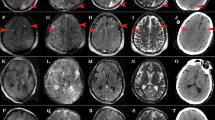Abstract
Background
Although intracranial hemorrhage and infarction have been reported in patients with H1N1 influenza infection treated with extracorporeal membrane oxygenation (ECMO), the clinical outcomes of these patients are not well described.
Methods
The authors present two patients with H1N1 influenza infection and diffuse cerebrovascular injury in the setting of ECMO.
Results
Diffuse cerebrovascular injury including intraparenchymal hemorrhage was found on head CT and brain MRI in both cases and confirmed by autopsy in one patient who died. Punctate foci of susceptibility effect were seen in both patients on T2* susceptibility-weighted or susceptibility-sensitive gradient echo sequences. These foci of susceptibility effect were consistent with infarction on histopathologic evaluation in the patient who died. The other patient made an excellent clinical recovery.
Conclusions
Frequent and early surveillance imaging should be obtained in patients with H1N1 influenza infection undergoing ECMO, although the presence of diffuse cerebral injury, including intraparenchymal hemorrhage and multifocal punctate susceptibility effect, does not necessarily portend a poor prognosis.


Similar content being viewed by others
References
CDC Estimates of 2009 H1N1 Influenza Cases: Hospitalizations and deaths in the United States. April 2009–February 13, 2010. 2010. www.cdc.gov/h1n1flu/estimates_2009_h1n1.htm.
Nin N, Soto L, Hurtado J, et al. Clinical characteristics and outcomes of patients with 2009 influenza A (H1N1) virus infection with respiratory failure requiring mechanical ventilation. J Crit Care. 2010; doi:10.1016/j.crc.2010.05.031.
Davies A, Jones D, Bailey M, et al. Extracorporeal membrane oxygenation for 2009 influenza A(H1N1) acute respiratory distress syndrome. JAMA. 2009;302:1888–95.
Miller RR 3rd, Markewitz BA, Rolfs RT, et al. Clinical findings and demographic factors associated with ICU admission in Utah due to novel 2009 influenza A(H1N1) infection. Chest. 2010;137:752–8.
Lidegran MK, Mosskin M, Ringertz HG, et al. Cranial CT for diagnosis of intracranial complications in adult and pediatric patients during ECMO: clinical benefits in diagnosis and treatment. Acad Radiol. 2007;14:62–71.
Weitkamp JH, Spring MD, Brogan T, et al. Influenza A virus-associated acute necrotizing encephalopathy in the United States. Pediatr Infect Dis J. 2004;23:259–63.
Lyon JB, Remigio C, Milligan T, Deline C. Acute necrotizing encephalopathy in a child with H1N1 influenza infection. Pediatr Radiol. 2010;40:200–5.
Zanatta P, Forti A, Bosco E, et al. Microembolic signals, strategy to prevent gas embolism during extracorporeal membrane oxygenation. J Cardiothorac Surg. 2010;5:5.
Jonas RA. The effect of extracorporeal life support on the brain: cardiopulmonary bypass. Semin Perinatol. 2005;29:51–7.
Dexter F, Hindman BJ. Recommendations for hyperbaric oxygen therapy of cerebral air embolism based on a mathematical model of bubble absorption. Anesth Analg. 1997;84:1203–7.
Jeon S-B, Kang D-W. Neurological picture. Cerebral air emboli on T2-weighted gradient-echo magnetic resonance imaging. J Neurol Neurosurg Psychiatr. 2007;78:871.
Idbaih A, Boukobza M, Crassard I, et al. MRI of clot in cerebral venous thrombosis: high diagnostic value of susceptibility-weighted images. Stroke. 2006;37:991–5.
Boukobza M, Crassard I, Bousser MG, Chabriat H. MR imaging features of isolated cortical vein thrombosis: diagnosis and follow-up. AJNR Am J Neuroradiol. 2009;30:344–8.
Kim HS, Lee DH, Choi CG, et al. Progression of middle cerebral artery susceptibility sign on T2*-weighted images: its effect on recanalization and clinical outcome after thrombolysis. AJR Am J Roentgenol. 2006;187:W650–7.
Conflict of interest
None.
Author information
Authors and Affiliations
Corresponding author
Rights and permissions
About this article
Cite this article
Chow, F.C., Edlow, B.L., Frosch, M.P. et al. Outcome in Patients with H1N1 Influenza and Cerebrovascular Injury Treated with Extracorporeal Membrane Oxygenation. Neurocrit Care 15, 156–160 (2011). https://doi.org/10.1007/s12028-011-9534-7
Published:
Issue Date:
DOI: https://doi.org/10.1007/s12028-011-9534-7




